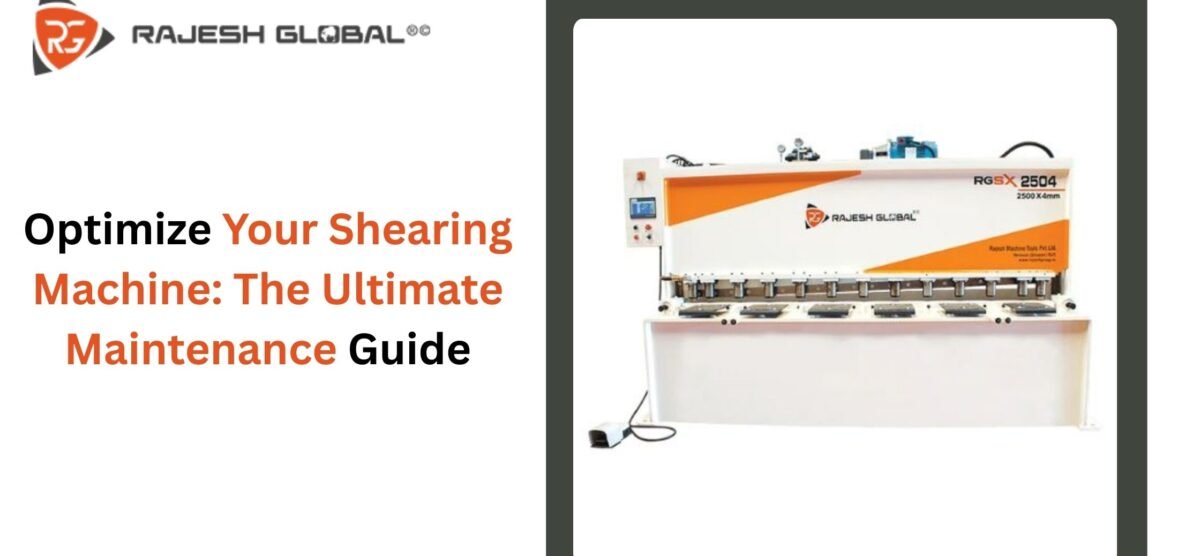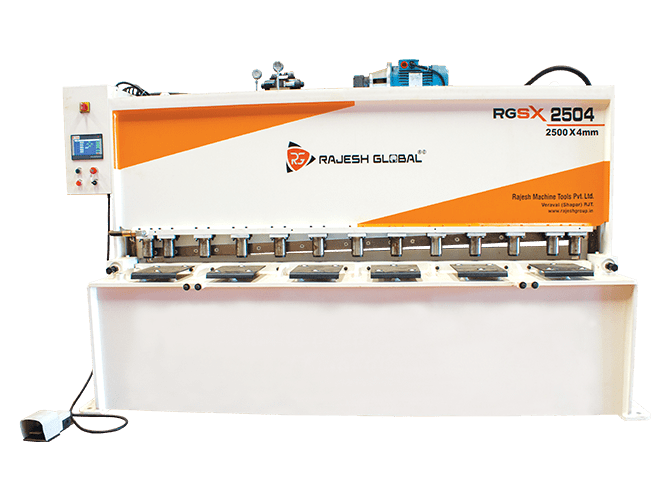Blog

Optimize Your Shearing Machine: The Ultimate Maintenance Guide
A well-maintained shearing machine is the backbone of any efficient metal fabrication shop. Regular maintenance not only extends the lifespan of your equipment but also ensures consistent, high-quality cuts, reduces downtime, and maximizes return on investment. In this comprehensive guide, Rajesh Machine Tools shares expert insights and actionable tips to help you optimize your shearing machine for peak performance.
Understanding Your Shearing Machine: Types and Key Components
Contents
- 1 Understanding Your Shearing Machine: Types and Key Components
- 2 Lubrication: The Lifeline of Shearing Machines
- 3 Blade Maintenance: Ensuring Clean, Precise Cuts
- 4 Hydraulic System Care: Power and Precision
- 5 Electrical Systems: Safety and Reliability
- 6 Cleanliness: The Foundation of Machine Longevity
- 7 Operator Training: The Human Factor in Maintenance
- 8 Preventive Maintenance Schedule: Planning for Peak Performance
- 9 Advanced Tips: Maximizing Shearing Machine ROI
- 10 Troubleshooting Common Shearing Machine Issues
- 11 The Rajesh Machine Tools Advantage
- 12 Conclusion: Make Maintenance Your Competitive Edge
Before diving into maintenance, it’s essential to understand the basic types and components of shearing machines:
- Types: Manual, treadle, hydraulic, and CNC shearing machines.
- Key Components: Blades, bearings, gears, hydraulic system, electrical controls, and frame.
Knowing your machine’s configuration and critical parts helps in targeting maintenance efforts effectively.
Lubrication: The Lifeline of Shearing Machines
Proper lubrication is vital to reduce friction, minimize wear, and prevent premature breakdowns. Focus on:
- Bearings and Gears: Lubricate as per manufacturer recommendations.
- Hydraulic Systems: Use the correct hydraulic oil and check levels regularly.
- Lubrication Schedule: Develop a routine based on machine usage and environment.
Neglecting lubrication can lead to increased energy consumption and costly repairs.
Blade Maintenance: Ensuring Clean, Precise Cuts
Blades are the heart of any shearing machine. To maintain optimal cutting quality:
- Regular Inspection: Check for nicks, dullness, or misalignment.
- Sharpening/Replacement: Sharpen blades before they become excessively dull. Replace if damaged.
- Blade Clearance: Adjust the gap according to material thickness to prevent burrs and uneven cuts.
A sharp, well-aligned blade reduces machine load and improves cut quality.
Hydraulic System Care: Power and Precision
Hydraulic shearing machines rely on robust hydraulic systems for smooth operation. Key maintenance steps include:
- Oil Quality: Change hydraulic oil at recommended intervals to prevent contamination.
- Seal Inspection: Check for leaks or worn seals that could reduce pressure and efficiency.
- Filter Maintenance: Clean or replace filters to ensure optimal oil flow.
Ignoring hydraulic maintenance can result in erratic operation and reduced cutting force.
Electrical Systems: Safety and Reliability
Electrical components are crucial for both safety and functionality. Maintain your system by:
- Inspecting Wiring: Look for loose, frayed, or corroded connections.
- Testing Controls: Regularly test emergency stops, limit switches, and control panels.
- Panel Cleanliness: Keep electrical panels dust-free to prevent overheating.
Routine electrical checks minimize the risk of unexpected shutdowns and hazards.
Cleanliness: The Foundation of Machine Longevity
A clean machine is a productive machine. Best practices include:
- Daily Cleaning: Remove metal shavings, dust, and debris from the cutting area and moving parts.
- Work Area Organization: Keep the area around the machine clear to prevent accidents and improve workflow.
- Corrosion Prevention: Wipe down exposed metal surfaces and apply protective coatings as needed.
Cleanliness not only extends machine life but also enhances operator safety.
Operator Training: The Human Factor in Maintenance
Skilled operators are your first line of defense against machine issues. Invest in:
- Comprehensive Training: Ensure operators understand machine functions, safety protocols, and basic troubleshooting.
- Refresher Courses: Regularly update training to cover new technologies and maintenance techniques.
- Maintenance Awareness: Encourage operators to report unusual noises, vibrations, or performance drops immediately.
Well-trained operators help catch problems early, reducing costly downtime.
Preventive Maintenance Schedule: Planning for Peak Performance
A proactive maintenance schedule is essential for long-term reliability:
| Task | Frequency |
| Lubricate bearings/gears | Weekly |
| Inspect/adjust blades | Bi-weekly |
| Hydraulic oil check/change | Monthly/Annually |
| Electrical system check | Monthly |
| Clean machine and area | Daily |
| Operator training | Quarterly |
Customize this schedule based on your machine’s workload and manufacturer’s recommendations.
Advanced Tips: Maximizing Shearing Machine ROI
- Monitor Blade Wear Patterns: Uneven wear may indicate misalignment or improper clearance.
- Track Machine Usage: Use digital counters or logs to schedule maintenance based on actual usage hours.
- Upgrade Safety Features: Retrofit older machines with modern safety devices for enhanced protection.
- Invest in Quality Spares: Use genuine replacement parts to maintain performance and warranty coverage.
Troubleshooting Common Shearing Machine Issues
| Symptom | Possible Cause | Solution |
| Inaccurate cuts | Dull/misaligned blades | Sharpen/align blades |
| Hydraulic leaks | Worn seals/hoses | Replace seals/hoses |
| Excessive noise | Poor lubrication/bearing wear | Lubricate/replace bearings |
| Electrical faults | Loose wires/faulty switches | Inspect/repair connections |
| Uneven cutting force | Low hydraulic pressure | Check oil level/filters |
Quick troubleshooting minimizes downtime and protects your investment.
The Rajesh Machine Tools Advantage
Choosing Rajesh Machine Tools means partnering with a leader committed to your success. Our machines are engineered for durability, easy maintenance, and operator safety. We provide:
- Expert technical support and training
- Genuine spare parts and prompt service
- Customizable maintenance plans
Conclusion: Make Maintenance Your Competitive Edge
Optimizing your shearing machine through regular, thorough maintenance is the smartest way to ensure consistent quality, safety, and profitability. By following these expert guidelines from Rajesh Machine Tools, you’ll extend your machine’s lifespan, reduce costs, and keep your production line running at its best.
Ready to elevate your operations? Contact Rajesh Machine Tools for tailored maintenance solutions and expert advice to keep your shearing machines performing at their peak.






